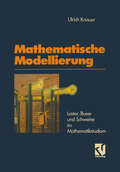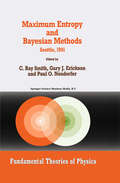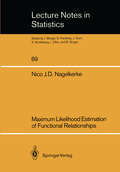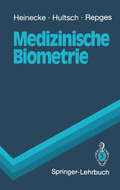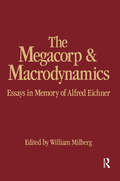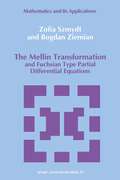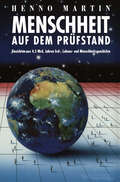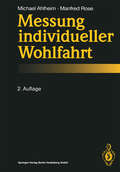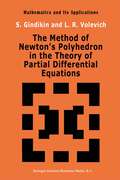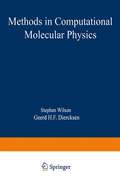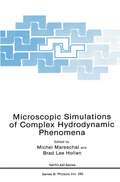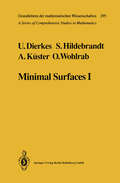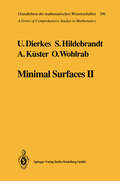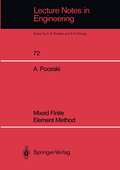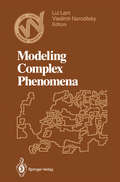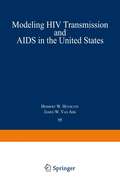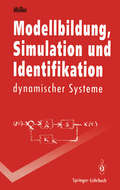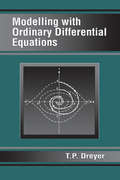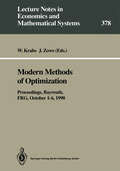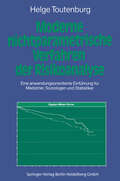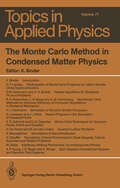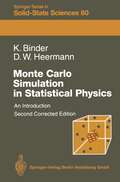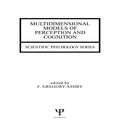- Table View
- List View
Maximum Entropy and Bayesian Methods: Seattle, 1991 (Fundamental Theories of Physics #50)
by C. R. Smith G. Erickson Paul O. NeudorferBayesian probability theory and maximum entropy methods are at the core of a new view of scientific inference. These `new' ideas, along with the revolution in computational methods afforded by modern computers, allow astronomers, electrical engineers, image processors of any type, NMR chemists and physicists, and anyone at all who has to deal with incomplete and noisy data, to take advantage of methods that, in the past, have been applied only in some areas of theoretical physics. This volume records the Proceedings of Eleventh Annual `Maximum Entropy' Workshop, held at Seattle University in June, 1991. These workshops have been the focus of a group of researchers from many different fields, and this diversity is evident in this volume. There are tutorial papers, theoretical papers, and applications in a very wide variety of fields. Almost any instance of dealing with incomplete and noisy data can be usefully treated by these methods, and many areas of theoretical research are being enhanced by the thoughtful application of Bayes' theorem. The contributions contained in this volume present a state-of-the-art review that will be influential and useful for many years to come.
Maximum Likelihood Estimation of Functional Relationships (Lecture Notes in Statistics #69)
by Nico J.D. NagelkerkeThe theory of functional relationships concerns itself with inference from models with a more complex error structure than those existing in regression models. We are familiar with the bivariate linear relationship having measurement errors in both variables and the fact that the standard regression estimator of the slope underestimates the true slope. One complication with inference about parameters in functional relationships, is that many of the standard properties of likelihood theory do not apply, at least not in the form in which they apply to e.g. regression models. This is probably one of the reasons why these models are not adequately discussed in most general books on statistics, despite their wide applicability. In this monograph we will explore the properties of likelihood methods in the context of functional relationship models. Full and conditional likelihood methods are both considered. Possible modifications to these methods are considered when necessary. Apart from exloring the theory itself, emphasis shall be placed upon the derivation of useful estimators and their second moment properties. No attempt is made to be mathematically rigid. Proofs are usually outlined with extensive use of the Landau 0(.) and 0(.) notations. It is hoped that this shall provide more insight than the inevitably lengthy proofs meeting strict standards of mathematical rigour.
Medizinische Biometrie: Biomathematik und Statistik (Springer-Lehrbuch)
by Achim Heinecke Ekhard Hultsch Rudolf RepgesDie Biometrie ist nicht nur für die medizinische Wissenschaft unverzichtbar geworden, sie ist auch wichtig für den klinisch tätigen Arzt. Das Erkennen von Krankheiten und die Beurteilung des Erfolgs therapeutischer oder präventiver Maßnahmen beruhen auf empirischem Wissen. Alle hieraus gezogenen Schlußfolgerungen sind somit Wahrscheinlichkeitsaussagen. Daten verläßlich zu gewinnen und richtig zu interpretieren ist äußerst wichtig, um Risiken abschätzen zu können. Dazu muß man die Methoden kennen. In diesem Taschenlehrbuch werden die wichtigsten biometrischen Verfahren dargestellt. Damit kann man aufgrund systematisch erhobener Daten und sorgfältig geplanter Beobachtungen zu Entscheidungen mit definierter Sicherheit gelangen. Da sich dieses Lehrbuch eng am Gegenstandskatalog orientiert, eignet es sich besonders für Studenten als Ergänzung zur Vorlesung. Für die Doktorarbeit braucht man die dargestellten Methoden auf jeden Fall!
The Megacorp and Macrodynamics: Essays in Memory of Alfred Eichner
by William MilbergThese essays on Post-Keynesian economics were written expressly for a volume to honour the life and work of Alfred Eichner. The original countributions - that critically examine and extend ideas in Eichner's "The Macrodynamics of Advanced Market Economies" are organized in seven sections that correspond to areas of economics in which Eichner made a significant contribution. Part 1 deals with the megacorp, a theory of firm pricing and investment that was one of Eichner's most important contributions. Issues of productivity and technical change, that lie at the center of Eichner's macrodynamic model, are the focus of part 1 and parts 3 and 4 elaborate on Eichner's work on growth and money and yield insights into the theoretical disagreements among the Post-Keynesians themselves. Part 5 presents a number of examples of non-neo-classical model building. Part 6 opens with a critique of the "new economic history" that leads to other essays on thorny methodological issues confronting Post-Keynesians. Part 7 gives a European perspective on North American Post-Keynesian economics. The essays reveal the relationships between Eichner's work and Institutionalist and Marxian economics. At the same time, the book raises current theoretical conflicts among these groups as well as among Post-Keynesians themselves. This book compliments Alfred S.Eichner's "The Macrodynamics of Advanced Market Economies", also published in 1991, and is appropriate for scholars and upper-level undergraduates and graduate students.
The Megacorp and Macrodynamics: Essays in Memory of Alfred Eichner
by William MilbergThese essays on Post-Keynesian economics were written expressly for a volume to honour the life and work of Alfred Eichner. The original countributions - that critically examine and extend ideas in Eichner's "The Macrodynamics of Advanced Market Economies" are organized in seven sections that correspond to areas of economics in which Eichner made a significant contribution. Part 1 deals with the megacorp, a theory of firm pricing and investment that was one of Eichner's most important contributions. Issues of productivity and technical change, that lie at the center of Eichner's macrodynamic model, are the focus of part 1 and parts 3 and 4 elaborate on Eichner's work on growth and money and yield insights into the theoretical disagreements among the Post-Keynesians themselves. Part 5 presents a number of examples of non-neo-classical model building. Part 6 opens with a critique of the "new economic history" that leads to other essays on thorny methodological issues confronting Post-Keynesians. Part 7 gives a European perspective on North American Post-Keynesian economics. The essays reveal the relationships between Eichner's work and Institutionalist and Marxian economics. At the same time, the book raises current theoretical conflicts among these groups as well as among Post-Keynesians themselves. This book compliments Alfred S.Eichner's "The Macrodynamics of Advanced Market Economies", also published in 1991, and is appropriate for scholars and upper-level undergraduates and graduate students.
The Mellin Transformation and Fuchsian Type Partial Differential Equations (Mathematics and its Applications #56)
by Zofia Szmydt B. ZiemianMenschheit auf dem Prüfstand: Einsichten aus 4,5 Milliarden Jahren Erd -, Lebens- und Menschheitsgeschichte
by Henno MartinThe Method of Newton’s Polyhedron in the Theory of Partial Differential Equations (Mathematics and its Applications #86)
by S.G. Gindikin L. VolevichMethods in Computational Molecular Physics (Nato Science Series B: #293)
by Stephen Wilson Geerd H. F. DiercksenThis volume records the lectures given at a NATO Advanced Study Institute on Methods in Computational Molecular Physics held in Bad Windsheim, Germany, from 22nd July until 2nd. August, 1991. This NATO Advanced Study Institute sought to bridge the quite considerable gap which exist between the presentation of molecular electronic structure theory found in contemporary monographs such as, for example, McWeeny's Methods 0/ Molecular Quantum Mechanics (Academic Press, London, 1989) or Wilson's Electron correlation in moleeules (Clarendon Press, Oxford, 1984) and the realization of the sophisticated computational algorithms required for their practical application. It sought to underline the relation between the electronic structure problem and the study of nuc1ear motion. Software for performing molecular electronic structure calculations is now being applied in an increasingly wide range of fields in both the academic and the commercial sectors. Numerous applications are reported in areas as diverse as catalysis and interstellar chernistry, drug design and environmental studies, molecular biology and solid state physics. The range of applications continues to increase as scientists recognize the importance of molecular structure studies to their research activities. Recent years have seen a growing dependence of these applications on program packages, which are often not in the public domain and which may have a somewhat lirnited range of applicability dicta ted by the particular interests and prejudices of the program author.
Microscopic Simulations of Complex Hydrodynamic Phenomena (Nato Science Series B: #292)
by Michel Mareschal Brad Lee HolianThis volume contains the proceedings of a NATO Advanced Study Institute which was held in Alghero, Sardinia, in July 1991. The development of computers in the recent years has lead to the emergence of unconventional ideas aiming at solving old problems. Among these, the possibility of computing directly fluid flows from the trajectories of constituent particles has been much exploited in the last few years: lattice gases cellular automata and more generally Molecular Dynamics have been used to reproduce and study complex flows. Whether or not these methods may someday compete with more traditional approaches is a question which cannot be answered at the present time: it will depend on the new computer architectures as well as on the possibility to develop very simple models to reproduce the most complex phenomena taking place in the approach of fully developed turbulence or plastic flows. In any event, these molecular methods are already used, and sometimes in an applied engineering context, to study strong shock waves, chemistry induced shocks or motion of dislocations in plastic flows, that is in domains where a fully continuum description appears insufficient. The main topic of our Institute was the molecular simulations of fluid flows. The project to hold this Institute was made three years ago, in the summer of 1989 during a NATO workshop in Brussels on the same subject.
Minimal Surfaces I: Boundary Value Problems (Grundlehren der mathematischen Wissenschaften #295)
by Ulrich Dierkes Stefan Hildebrandt Albrecht Küster Ortwin WohlrabMinimal surfaces I is an introduction to the field of minimal surfaces and apresentation of the classical theory as well as of parts of the modern development centered around boundary value problems. Part II deals with the boundary behaviour of minimal surfaces. Part I is particularly apt for students who want to enter this interesting area of analysis and differential geometry which during the last 25 years of mathematical research has been very active and productive. Surveys of various subareas will lead the student to the current frontiers of knowledge and can alsobe useful to the researcher. The lecturer can easily base courses of one or two semesters on differential geometry on Vol. 1, as many topics are worked out in great detail. Numerous computer-generated illustrations of old and new minimal surfaces are included to support intuition and imagination. Part 2 leads the reader up to the regularity theory fornonlinear elliptic boundary value problems illustrated by a particular and fascinating topic. There is no comparably comprehensive treatment of the problem of boundary regularity of minimal surfaces available in book form. This long-awaited book is a timely and welcome addition to the mathematical literature.
Minimal Surfaces II: Boundary Regularity (Grundlehren der mathematischen Wissenschaften #296)
by Ulrich Dierkes Stefan Hildebrandt Albrecht Küster Ortwin WohlrabMinimal Surfaces I is an introduction to the field of minimal surfaces and a presentation of the classical theory as well as of parts of the modern development centered around boundary value problems. Part II deals with the boundary behaviour of minimal surfaces. Part I is particularly apt for students who want to enter this interesting area of analysis and differential geometry which during the last 25 years of mathematical research has been very active and productive. Surveys of various subareas will lead the student to the current frontiers of knowledge and can also be useful to the researcher. The lecturer can easily base courses of one or two semesters on differential geometry on Vol. 1, as many topics are worked out in great detail. Numerous computer-generated illustrations of old and new minimal surfaces are included to support intuition and imagination. Part 2 leads the reader up to the regularity theory for nonlinear elliptic boundary value problems illustrated by a particular and fascinating topic. There is no comparably comprehensive treatment of the problem of boundary regularity of minimal surfaces available in book form. This long-awaited book is a timely and welcome addition to the mathematical literature.
Mixed Finite Element Method (Lecture Notes in Engineering #72)
by Apostol PoceskiIn this book, based on 16 years of work on the finite element method, the author presents the essence of a new, direct approach to the FEM. The work is focused on the mixed method and shows how reliable results may be obtained with fewer equations than usual. The basic principles, the fundamentals and the essence of the FEM are presented, then the method is applied to the analysis of one, two, and three-dimensional problems. It is shown that mixed elements offer superior accuracy compared with stiffness elements. Finally, some new achievements and perspectives for further development are presented. The book is intended for undergraduate and graduate students, mathematicians, research engineers and practicing engineers. To understand the book, a familiarity with classical mechanics is sufficient.
Modeling Complex Phenomena: Proceedings of the Third Woodward Conference, San Jose State University, April 12–13, 1991 (Woodward Conference)
by Lui Lam Vladimir NaroditskyOnce upon a time, science was not divided into disciplines as we know it today. There was no distinction between so-called social and natural sciences, not to mention the fragmentation of the latter into physics, chemistry, biology, geology, etc. According to legend, the scientists those days would do their research in whatever environment they happened to find comfortable, which more often than not was in bathtubs or giant hot tubs - remember Archimedes! Then, somehow, these days we find ourselves compartmentalized into different departments in our universities, or divisions in our research institutes. (We suspect, for one thing, that is to ensure that we will get our paychecks delivered on time at the end of each month. ) Anyway, as anyone who has worked in the real world knows: when one is confronted with a completely new problem or phenomenon, it is usually impossible to neatly assign the problem to physics, chemistry, or, for that matter, computer science. One needs to recall and fuse together the knowledge one learned before and, if that alone is insufficient, to consult experts in other areas. This points to the shortcomings of the compartmentalization of knowledge in our educational systems. In recent years, something has changed. Under the banner of Complex Systems, some brave souls are not afraid to tackle problems that are considered intractable by others, and dare to venture out of their trained disciplines or departments to which they are attached.
Modeling HIV Transmission and AIDS in the United States (Lecture Notes in Biomathematics #95)
by Herbert W. Hethcote James W. Van ArkThe disease that came to be called acquired immunodeficiency syndrome (AIDS) was first identified in the summer of 1981. By that time, nearly 100,000 persons in the United States may have been infected with human immunodeficiency virus (HIV). By the time the routes of transmission were clearly identified and HIV was established as the cause of AIDS in 1983, over 300,000 people may have been infected. That number has continued to increase, with approximately 1,000,000 Americans believed to be infected in 1991. The epidemic is of great public health concern because HlV is infectious, causes severe morbidity and death in most if not all of those infected, and often occurs in relatively young persons. In addition, the cost of medical care for a person with HIV disease is high, and the medical care needs of HIV-infected persons place a severe burden on the medical care systems in many areas. Understanding and controlling the HIV epidemic is a particularly difficult challenge. The long and variable period between HIV infection and clinical disease makes it difficult both to forecast the future magnitude of the epidemic, which is important for health care planning, and to estimate the number infected in the last several years, which is important for monitoring the current status of the epidemic.
Modellbildung, Simulation und Identifikation dynamischer Systeme (Springer-Lehrbuch)
by Dietmar P.F. MöllerModelling with Ordinary Differential Equations
by T.P. DreyerModelling with Ordinary Differential Equations integrates standard material from an elementary course on ordinary differential equations with the skills of mathematical modeling in a number of diverse real-world situations. Each situation highlights a different aspect of the theory or modeling. Carefully selected exercises and projects present excellent opportunities for tutorial sessions and self-study.This text/reference addresses common types of first order ordinary differential equations and the basic theory of linear second order equations with constant coefficients. It also explores the elementary theory of systems of differential equations, Laplace transforms, and numerical solutions. Theorems on the existence and uniqueness of solutions are a central feature. Topics such as curve fitting, time-delay equations, and phase plane diagrams are introduced. The book includes algorithms for computer programs as an integral part of the answer-finding process. Professionals and students in the social and biological sciences, as well as those in physics and mathematics will find this text/reference indispensable for self-study.
Modelling with Ordinary Differential Equations
by T.P. DreyerModelling with Ordinary Differential Equations integrates standard material from an elementary course on ordinary differential equations with the skills of mathematical modeling in a number of diverse real-world situations. Each situation highlights a different aspect of the theory or modeling. Carefully selected exercises and projects present excellent opportunities for tutorial sessions and self-study.This text/reference addresses common types of first order ordinary differential equations and the basic theory of linear second order equations with constant coefficients. It also explores the elementary theory of systems of differential equations, Laplace transforms, and numerical solutions. Theorems on the existence and uniqueness of solutions are a central feature. Topics such as curve fitting, time-delay equations, and phase plane diagrams are introduced. The book includes algorithms for computer programs as an integral part of the answer-finding process. Professionals and students in the social and biological sciences, as well as those in physics and mathematics will find this text/reference indispensable for self-study.
Modern Methods of Optimization: Proceedings of the Summer School “Modern Methods of Optimization”, held at the Schloß Thurnau of the University of Bayreuth, Bayreuth, FRG, October 1–6, 1990 (Lecture Notes in Economics and Mathematical Systems #378)
by Werner Krabs Jochem ZoweThis volume contains the proceedings of the summer school "Modern Methods of Optimization", held at the Schlof3 Thurnau of the University of Bayreuth, October 1-6, 1990. Like other branches of applied mathematics the area of optimization is undergoing a rapid development since the beginning of the computer age. Optimizaiton methods are of increasing importance for both, science and industry. The aim of the summer school was to present state-of-the-art knowledge by inviting 12 specialists from Op timization (and related fields) to present their areas of activity in the form of survey talks. This volume contains 10 of these presentations in slightly extended form. Most lectures started from an undergraduate level and outlinad the developments up to the latest scientifique achievements. This enabled the audience, consisting of about 45 students and young researchers, to get an excellent overview of the latest trends in Optimization as w~ll as a grasp of the breadth of its potential applications. Equally important to the success of the summer school was the "nonmeasurable" part of the activities inherent in such a summer school. Here the inspiring atmosphere of a place like Thurnau helped to establish numerous contacts between "teachers" and "students". The summer school was organized by the Universitii. t Bayreuth together with the Technische Hochschule Darmstadt and was generously sponsored by the Volkswagen stiftung and the Universitii. tsverein Bayreuth. Their interest in the meeting and their support is hereby gratefully acknowledged.
Moderne Nichtparametrische Verfahren der Risikoanalyse: Eine anwendungsorientierte Einführung für Mediziner, Soziologen und Statistiker
by Helge ToutenburgThe Monte Carlo Method in Condensed Matter Physics (Topics in Applied Physics #71)
by A. Baumgärtner Kurt Binder A. N. Burkitt D. M. Ceperley H. De Raedt A. M. Ferrenberg D. W. Heermann H. J. Herrmann D. P. Landau D. Levesque W. Von Linden J. D. Reger K. E. Schmidt W. Selke D. Stauffer R. H. Swendsen J. S. Wang J. J. Weis A. P. YoungThe Monte Carlo method is now widely used and commonly accepted as an important and useful tool in solid state physics and related fields. It is broadly recognized that the technique of "computer simulation" is complementary to both analytical theory and experiment, and can significantly contribute to ad vancing the understanding of various scientific problems. Widespread applications of the Monte Carlo method to various fields of the statistical mechanics of condensed matter physics have already been reviewed in two previously published books, namely Monte Carlo Methods in Statistical Physics (Topics Curro Phys. , Vol. 7, 1st edn. 1979, 2ndedn. 1986) and Applications of the Monte Carlo Method in Statistical Physics (Topics Curro Phys. , Vol. 36, 1st edn. 1984, 2nd edn. 1987). Meanwhile the field has continued its rapid growth and expansion, and applications to new fields have appeared that were not treated at all in the above two books (e. g. studies of irreversible growth phenomena, cellular automata, interfaces, and quantum problems on lattices). Also, new methodic aspects have emerged, such as aspects of efficient use of vector com puters or parallel computers, more efficient analysis of simulated systems con figurations, and methods to reduce critical slowing down at i>hase transitions. Taken together with the extensive activity in certain traditional areas of research (simulation of classical and quantum fluids, of macromolecular materials, of spin glasses and quadrupolar glasses, etc.
Monte Carlo Simulation in Statistical Physics: An Introduction (Springer Series in Solid-State Sciences #80)
by Kurt Binder Dieter W. HeermannWhen learning very formal material one comes to a stage where one thinks one has understood the material. Confronted with a "realiife" problem, the passivity of this understanding sometimes becomes painfully elear. To be able to solve the problem, ideas, methods, etc. need to be ready at hand. They must be mastered (become active knowledge) in order to employ them successfully. Starting from this idea, the leitmotif, or aim, of this book has been to elose this gap as much as possible. How can this be done? The material presented here was born out of a series of lectures at the Summer School held at Figueira da Foz (Portugal) in 1987. The series of lectures was split into two concurrent parts. In one part the "formal material" was presented. Since the background of those attending varied widely, the presentation of the formal material was kept as pedagogic as possible. In the formal part the general ideas behind the Monte Carlo method were developed. The Monte Carlo method has now found widespread appli cation in many branches of science such as physics, chemistry, and biology. Because of this, the scope of the lectures had to be narrowed down. We could not give a complete account and restricted the treatment to the ap plication of the Monte Carlo method to the physics of phase transitions. Here particular emphasis is placed on finite-size effects.
Multidimensional Models of Perception and Cognition (Scientific Psychology Series)
by F. Gregory AshbyThe mental representations of perceptual and cognitive stimuli vary on many dimensions. In addition, because of quantal fluctuations in the stimulus, spontaneous neural activity, and fluctuations in arousal and attentiveness, mental events are characterized by an inherent variability. During the last several years, a number of models and theories have been developed that explicitly assume the appropriate mental representation is both multidimensional and probabilistic. This new approach has the potential to revolutionize the study of perception and cognition in the same way that signal detection theory revolutionized the study of psychophysics. This unique volume is the first to critically survey this important new area of research.
